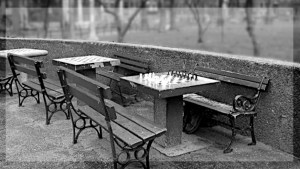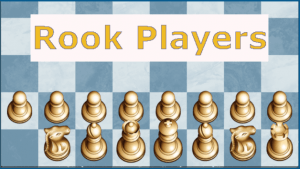
Great Early Chess Libraries of the United States
|
Once again I'm indebted to my dear friend Deb for finding this. We were searching for the whereabouts of a certain chess board and chess set that once belonged to E. B. Cook and was used when Frederick Perrin, Thomas Frere and Willard Fiske in consultation beat Paul Morphy in Cook's home in Hoboken. (see Perrin). Cook gave the memorable paraphernalia to Dr. Herman Keidanz (Dr. Hermann Keidanski), a noted chess problemist from Berlin who had moved to NYC. While unable to learn the fate of the board and pieces, Deb did find this interesting article from the Princton, N.J. library on the early chess libraries in the United States. Coincidenally, Perrin had been a professor at the College of New Jersey that was renamed "Princeton" in 1896. Fiske, Cook and Keidanz also play a part in the following story.
       _________________________________________________________________
While libraries are generally described by the number of volumes, far more relevant to both the collectors and the researchers is the quality of the collection.
Daniel Willard Fiske, "the Book of the First American Chess Congress" :
Several Chess libraries have been collected in this country. We have seen that already in the last century, Lewis Rou possessed a number of works upon the game. In this century our information is more exact. Judge Fisk collected between one and two hundred volumes which were sold at his death. Professor Anderson, formerly of Columbia College, New York, has a Chess library of considerable size, composed in part of the duplicates belonging to the Bledow collection. Professor H. R. Agnel of West Point, Mr. H. P. Russ and Mr. F. B. Wightman of New York, Mr. Eugene B. Cook of Hoboken, and several others within a few years, have become interested in this branch of bibliomania. But the finest collection in the land, and one of the largest and most important in the world, is that of Professor George Allen of Philadelphia. It numbers over six hundred volumes, and is rapidly increasing. It contains many rare works, and among them books from the libraries of Mercier, Schumacher, and Lewis. and The bibliography of the game has grown to be a subject of study, and Cancellieri, Hoeck, Walker, Oettinger, and Schmid have compiled catalogues of chess works, while the magazines have been filled with critical articles of great merit on individual authors. Chess libraries have been collected, with the loving assiduity of the bibliomaniac, by Mercier, Walker, Lewis, Bledow, Alliey, von der Lasa, Schumacher, and Franz, in the Old World; and by Allen, Agnel, and Anderson in the New. Art has lent its aid to illustrate the game, and the chess pictures of Retzsch, Hasenclever, Meissonier, Marlet, and Stone, are well and widely known. "Johnson's Universal Cyclopedia" 1893
Chess Libraries.—The literary elucidation of the game, with the branches that have developed in different countries, fills, in special chess libraries which have becen collected by many amateurs and public institutions, several thousands of volumes, consisting of theoretical works, collections of actually played games, books on endings and problems, chess periodicals, etc. The largest of the well-known chess libraries are those of J. G. White, of Cleveland ; Baron von Heydebrand und der Lasa, Wiesbaden, Germany; Charles A. Gilberg, Brooklyn, N. Y.; and Eugene B. Cook, Hoboken. "BCM," May 1888 Before leaving New York for Europe, Baron von der Lasa visited the club and won two games of Mr. Ryan. He also inspected the Chess libraries of Messrs. Cook and Gilberg. [v.d. lasa donated his "erneutes verzeichnis einer sammlung von schriften über das schachspiel" to the Philadelphia library in 1896] "American Chess Magazine," Sept. 1897 Francis Mercier, who refused to sit at the chess-board after the rising of what he regarded as as the wondrous McDonnell, formed a fine chess library consisting mainly of rare works which was sold after his death, in August, 1855. There were only between two and three hundred volumes in the collection. More important libraries of this nature sold by auction, during the past quarter century, are George Walker's, May 14, 1874; J. Rimington Wilson's, 1873; Sir Frederic Madden's, August, 1873; Channing W. Whitman's, May, 1874; C. E. B. Hoverbeck's, 1876 ; Robert Franz's, 1885; Vansittart's, 1886; George B. Fraser's, 1875, and H. Macdonald Dundee's, in 1876. The fifth, sixth and seventh were sold in Berlin. The leading collections in America are those of John G. White, Cleveland, Ohio (the largest known in the world); Chas. A. Gilberg, Eugene B. Cook, Hoboken, N. J.; James D. Seguin, New Orleans; Miron J. Hazeltine, New Hampshire; Prof. George Allen, of the University of Pennsylvania (deceased, whose labor of love, 1000 books, was purchased 'en bloc' by the Ridgway Branch of the Philadelphia Library, about 1880). In Europe, there are those of Joseph A. Leon, of London, and the Baron T. v. Heydebrand und der Lasa, Wiesbaden. The latter gentleman has about 2500 volumes, and the same number is possessed by Chas. A. Gilberg. The cover/thumbnail image is the Sphinx with the expression "ex oriente lux et ludus scaccorum" written on the base. This image was taken from "The Chess Monthy" which was edited by Willard Fiske.
 |






